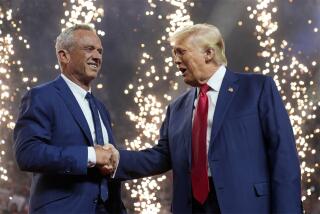To the End, Kerry Remained Secretive About His Decision
- Share via
PITTSBURGH — Sen. John F. Kerry had settled on his running mate, and he was ready to make the call.
Just after 6 p.m. Monday, he picked up the phone -- and talked to a worker in an airplane hangar at the Pittsburgh airport. The worker immediately set about adding a bright new decal to the side of the campaign plane.
It read: “Kerry Edwards.” Below that, another line was added: “A Stronger America.”
Kerry placed his call almost four hours before he notified his top aides that he had decided to ask Sen. John Edwards to join him on the Democratic presidential ticket -- and more than 13 hours before he contacted the North Carolinian himself. And Kerry’s unveiling of his choice exemplified the way he conducted his search for a running mate: thoroughly, personally and, most of all, privately.
Even the advisors closest to Kerry said they did not know which way he was leaning as he solicited their opinions during the last few months.
Forced to plan a rollout for a candidate whose identity was a secret, the campaign printed as many as five different versions of placards, buttons and stickers. Others who made it onto the campaign paraphernalia included Missouri Rep. Dick Gephardt, Iowa Gov. Tom Vilsack and Florida Sen. Bob Graham. On Tuesday, at a jubilant rally in downtown Pittsburgh where Kerry announced his pick, a smattering of “Kerry Graham” signs were held aloft in the crowd, having accidentally slipped into the mix.
Friends and associates said Kerry’s approach to selecting a running mate hewed to the method he applied to all major decisions. Detail-oriented and prone to playing devil’s advocate, the 19-year senator and former prosecutor sifts through volumes of information before coming to a conclusion. He will often engage in spirited debates and take opposing viewpoints.
“He does what he says he’s going to do, which is reach out and hear the thoughts of others, take their opinions seriously, step back and make his own decision,” said Mary Beth Cahill, Kerry’s campaign manager.
The way Kerry handled his vice presidential search was also influenced by his experience in 2000, when Al Gore’s campaign leaked to reporters that Kerry was on the short list. In the end, Kerry learned from television news reports that Gore had chosen Sen. Joe Lieberman of Connecticut.
“I think he felt that, having been through it before, he did not want this to be an invasive process,” one advisor said on condition of anonymity. “He really kept a lot to himself,” said David Thorne, a friend since he and Kerry attended Yale University and the twin brother of Kerry’s first wife. “I think all of us pretty much understood.... He never shared, I don’t believe, with anyone, his thinking.”
John Marttila, a Boston strategist who has worked with Kerry for decades, said the senator instructed the campaign staff not to gossip or discuss his possible choices. And the candidate’s conversations with advisors about the process were mostly one-sided.
“The rules were very clear,” Marttila said. “He welcomed advice, but there was no comment coming back.”
As he went about narrowing his choices, Kerry reviewed sheaths of documents and videotapes that detailed the backgrounds, professional experience and politics of 25 candidates.
Jim Johnson, who headed up the search for Kerry’s running mate, said, “When I first met with John, he said he didn’t want this to be just kind of rounding up the same old suspects, and so he said, ‘Let’s think about Republicans, let’s think about businessmen. If there are people in the academic or nonprofit world, let’s think about them.’ ”
Beginning in March, Johnson and Cahill met with Kerry about every 10 days to discuss the search process. In April, they began giving him memos on the various candidates.
“As we sat around, John would say, ‘Do we need more work here?’ and ‘Does this give us enough of a picture here?’ ” Johnson recounted.
Aides said that despite reports Kerry had narrowed his choices to three or so candidates, he never winnowed the possibilities to a formal short list. And just last week, they said, he raised names that had not been discussed for a month.
On Thursday, Cahill and Johnson gave Kerry a final batch of information he had requested. He apparently settled on Edwards sometime over the holiday weekend. As he was trundling through the Midwest on a three-day bus tour, he started drafting his announcement speech, Johnson said.
When Kerry returned to Pittsburgh on Monday morning, he discussed his pick with his wife, Teresa, aides said. He finally informed Cahill and Johnson of his choice that night around 10:30, as they were joining the Kerrys for a late dinner of fish soup and salad.
On Tuesday, Kerry rose about 6:15 a.m. and continued working on his remarks. As aides huddled in his kitchen, fielding calls and mapping out the day’s logistics, Kerry sat in his study with only his German shepherd, Kim, by his side. Shortly after 7:30, he called Edwards.
Despite Kerry’s determination to be the one to inform the various contenders of his decision, NBC broke the story just as Kerry was talking to his new running mate. Within 11 minutes, all the networks were reporting his pick.
Still, Gephardt said he learned of Kerry’s choice from the senator himself, as did Vilsack, according to an aide.
But Graham first heard the news from his wife and chief of staff, who both saw the news on cable television.
Times staff writers Nick Anderson, Ronald Brownstein, Maria L. La Ganga and James Rainey contributed to this report.
More to Read
Get the L.A. Times Politics newsletter
Deeply reported insights into legislation, politics and policy from Sacramento, Washington and beyond. In your inbox twice per week.
You may occasionally receive promotional content from the Los Angeles Times.










